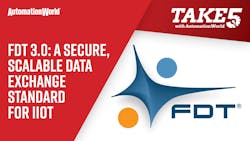FDT 3.0: A Secure, Scalable Data Exchange Standard for IIoT

Quick hits:
- FDT Group, an independent, international, not-for-profit industry association rolls out FDT 3.0, which supports Microsoft, Apple, and Linux environments.
- OPC Foundation offers a companion spec, FDT OPC UA, to enable uniform IT/OT data access across the enterprise.
- The FDThub repository is a one-stop-shop for end users to access device type managers (DTMs).
- The FDT 3.0 standard will enable “as-a-service” models for OEMs and device developers.
- FDT Group Releases Data Exchange Standard for Next-Gen Automation
- FDT Standard Looks to the Future - Empowering Digital Transformation
- ODVA Enters Into Agreements with FDT and Fieldcomm Group and Continues XDS Development to Expand Ethernet/IP Technology Ecosystem
- Visit PMMI's Business Intelligence Library and download their executive summaries of their latest reports for free
Hi, everyone, I’m Stephanie Neil and welcome to Take Five with Automation World.
There’s a topic that no one really talks about when discussing the internet of things.
And that is, how to get all of those devices, which may be on different networks, to connect to each other or to a PLC or DCS.
And how do you effectively configure, diagnose, and maintain hundreds or thousands of devices?
Well, the FDT Group, which is an international non-profit organization, has been providing an open standard for the integration of networks and devices for over 20 years.
It’s called the Field Device Tool technology. Used in process, hybrid, and discrete markets, it defines the data exchange interface between devices and each control system as well as engineering or asset management tools. It supports more than 18 different networks and as of last year, it is now fully Internet enabled.
In the past, the technology standard has worked only on a Microsoft desktop. But in June of 2020, the group released FDT 3.0, a platform-independent version of the standard that includes the FDT IIoT Server which supports Apple, Linux, and Microsoft environments and allows users to interact with it through a standard web browser.
In addition, the new version includes a developers’ toolkit that has common IIoT-ready components. This means device developers don’t need to spend time learning the nuances of the FDT standard to create the device type managers (or DTMs), which are software components that work on the device-specific data, functions, and rules.
Also important in FDT 3, is the built-in security using encrypted communications and certificates so that only authorized devices can talk to the server.
In addition, a collaboration with the OPC Foundation, has recently resulted in the FDT OPC UA companion spec, which enables uniform IT and OT data access to the enterprise through a new server-level Universal Device Information model.
These two groups have been collaborating since 2011 to present device and network level data access in a uniform way for higher level enterprise apps. But to meet the demands of cloud-based computing applications, the FDT 3 server is now natively integrated with an OPC UA server to mix and match any device with any device information model, from any vendor and on any network.
The FDT Server transparently unifies all device information and pushes the data to the enterprise to any OPC UA client in real-time. That means end user can now get direct access to data without having to go through each network and data model which removes the big communication road blocks of the past.
Also for end users, the group rolled out the FDThub repository for FDT Device Type Managers The hub, which can be in the cloud or on-premise, is where certified DTMs are stored and managed by giving the vendor community access to it. This solves a problem that users had in that they would have to visit multiple vendor websites to find the DTMs they needed. Now, it’s all in one spot and the user doesn’t even need to look for something, as the FDThub can automatically retrieve the DTM needed.
As a single server environment, FDT 3 can handle a plant, an entire enterprise, or could scale down to a single skid.
Glenn Schulz, FDT Group’s managing director gave me an example of an OEM delivering a bottling line to their end customer. They could put a small version of the server on a Linux application buried inside of the bottling line and monitor the health of all the assets to mmake adjustments or develop KPIs or dashboards. And it all scales up to a cloud-based environment.”
That, of course, means, this is a tool that could enable new “as-a-service” maintenance models for machine builders.
Schulz said, too, developers could set up am FDT-as-a-Service model as well, where they pre-deploy multiple instances in the cloud and set up a hosted service and project structure for facilities with all of the devices and networks pre-populated.
This way the customer could access a complete turnkey system without having to touch any of the infrastructure themselves.
Speaking of customers, I’m told there’s one large customer putting FDT 3 through its paces, and they should be going public with the results very soon. We’ll keep you posted on that. Until then, you can find out more information on the FDT Group in the links below.
Thanks for joining me on today’s Take Five with Automation World.
